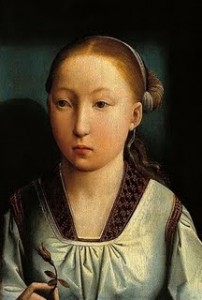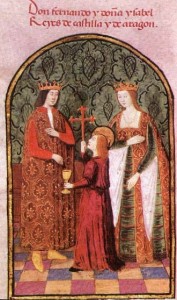 On this day in history, 15th* December 1485, Catherine of Aragon was born at the recently reformed fortified palace at Alcalá de Henares, a town just east of Madrid. Pregnancy had not stopped Catherine’s mother, Isabel I of Castile, waging war on the Moors and she had spent the summer of 1485 moving around Andalucia, following her troops’ campaign. Isabel and her troops finished warring for the year in September and the Royal Court travelled from Andalucia to Alcalá for the winter and for the impending birth.
On this day in history, 15th* December 1485, Catherine of Aragon was born at the recently reformed fortified palace at Alcalá de Henares, a town just east of Madrid. Pregnancy had not stopped Catherine’s mother, Isabel I of Castile, waging war on the Moors and she had spent the summer of 1485 moving around Andalucia, following her troops’ campaign. Isabel and her troops finished warring for the year in September and the Royal Court travelled from Andalucia to Alcalá for the winter and for the impending birth.
Catherine of Aragon, Catalina de Aragón, was the last of Ferdinand II of Aragon and Isabel I’s children and was named after her maternal great-grandmother, Catalina of Castile or Catherine of Lancaster. Giles Tremlett, in his biography of Catherine, writes of how we know various details about Catherine’s childhood because it was recorded by Gonzalo de Baeza, Isabel’s treasurer. For example, we know that she was baptised by the Bishop of Palencia and wore a a white brocade gown which was trimmed with gold lace and lined with green velvet and that Dutch olanda linen was used to make her sheets, pillowcases, nightshirts and bibs. We also know that scarlet Florentine cloth was ordered to make clothes, fresh cotton was used to stuff her crib mattress, a brass basin was used for washing her and that she owned a perfume sprinkler. Interesting little insights into the life of a newborn Spanish princess!
 When Catherine was just three years old, it was agreed that she should be betrothed to the heir to the English throne, Prince Arthur. The English ambassadors, Richard Nanfan and Thomas Savage, visited Medina del Campo, in Spain, in March 1489 to meet Ferdinand and Isabel and to discuss the matter. They saw little Catherine and were obviously happy with what they saw as the Treaty of Medina del Campo, a marriage alliance between England and Spain, was agreed and signed. Catherine was destined to be Queen of England, but not with Arthur at her side – he was to die just a few months after their marriage – but with King Henry VIII, a man known for his six wives and his tyranny. As Isabel lifted her little daughter for all to see on that visit, she could have had no idea that the Spanish princess, and future Queen of England, would end her days discarded, neglected and with only her faith to support her. A sad end to the life of a proud princess of Spain, daughter of the famous “Reyes Católicos”.
When Catherine was just three years old, it was agreed that she should be betrothed to the heir to the English throne, Prince Arthur. The English ambassadors, Richard Nanfan and Thomas Savage, visited Medina del Campo, in Spain, in March 1489 to meet Ferdinand and Isabel and to discuss the matter. They saw little Catherine and were obviously happy with what they saw as the Treaty of Medina del Campo, a marriage alliance between England and Spain, was agreed and signed. Catherine was destined to be Queen of England, but not with Arthur at her side – he was to die just a few months after their marriage – but with King Henry VIII, a man known for his six wives and his tyranny. As Isabel lifted her little daughter for all to see on that visit, she could have had no idea that the Spanish princess, and future Queen of England, would end her days discarded, neglected and with only her faith to support her. A sad end to the life of a proud princess of Spain, daughter of the famous “Reyes Católicos”.
You can read more about Catherine of Aragon at our special Catherine of Aragon Bio page which lists some of the articles I have written about her.
* David Starkey gives Catherine’s date of birth as the 16th December but Giles Tremlett gives it as the 15th. Alison Weir writes that Catherine was born during the night of the 15th/16th.
Notes and Sources
- Catherine of Aragon: Henry’s Spanish Queen, Giles Tremlett
I do have to say that I like Philippa Gregory’s book about Catherine (I believe it’s called “The Constant Princess,” but I’m not sure). Obviously fiction, but it shows Catherine as having a very happy childhood and truly being in love with Arthur (and he with her.) With the end of her life being so difficult, I like to think she lived for some time knowing she was loved and wanted.
Well, if she was born on the 15 Dec then we share the same day of birth! Very cool!
I wonder, if Ysabel had known what kind of jerks her daughters (Juana and Katharine) would be stuck with, if she would have re-thought her plans. After all, Ysabel was able to choose her own husband, and while Ferdinand was not faithful to her, he at least treated her with respect.
While it was true that Juana was very much in love with Philip, he was a total scum to her. Henry might have initially impressed her, especially considering at the beginning, Henry treated Katharine very well, but I like to think she would have rallied the Castilian army and marched on Henry for his about face toward Katharine.
I agree with you about Isabel, but at the time of marriage negotiations it wasn’t so much about the match with Henry (or Arthur before) but about the alliance between Spain and England, which would have been much more important at the time than any daughter’s happiness (or lack of). She may have been a “princess of the blood,” but she was still a girl. :-/